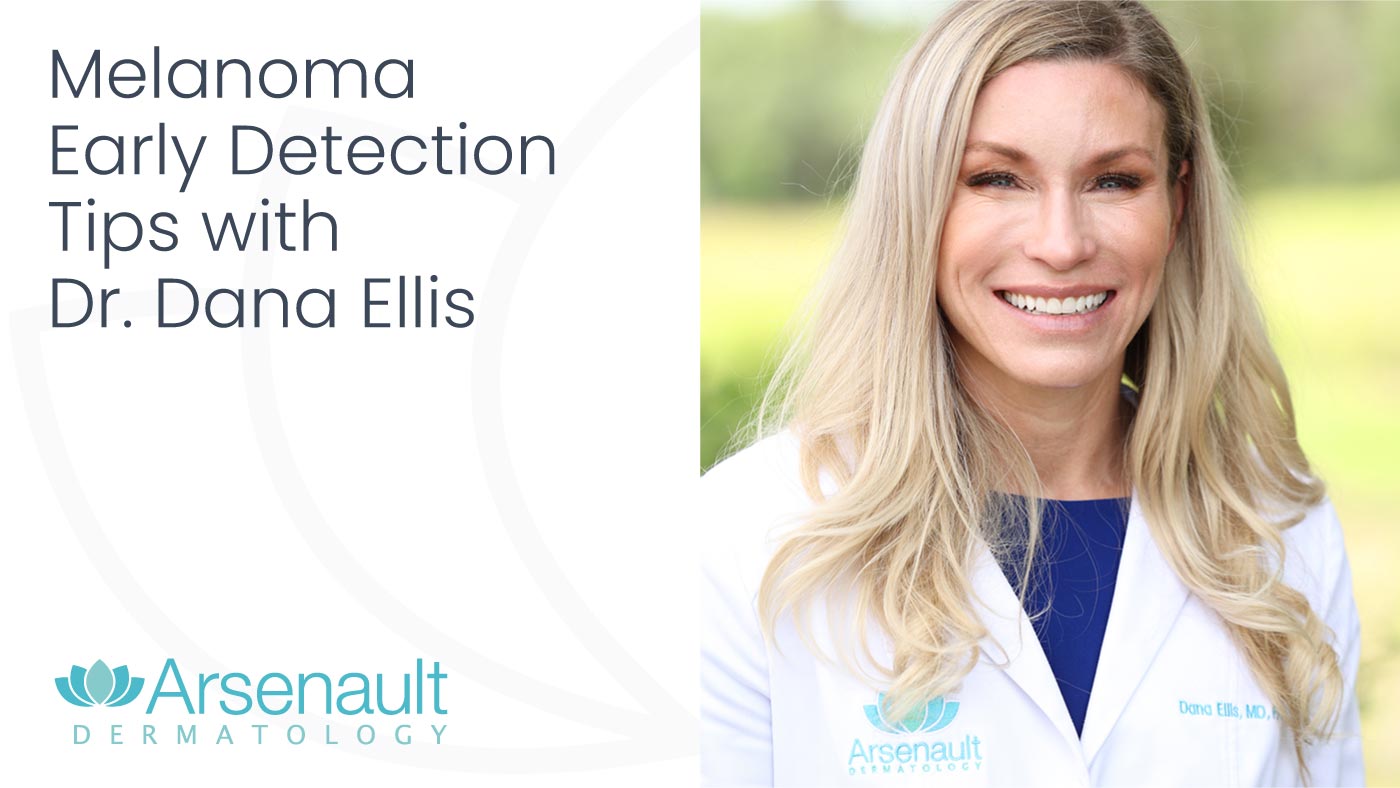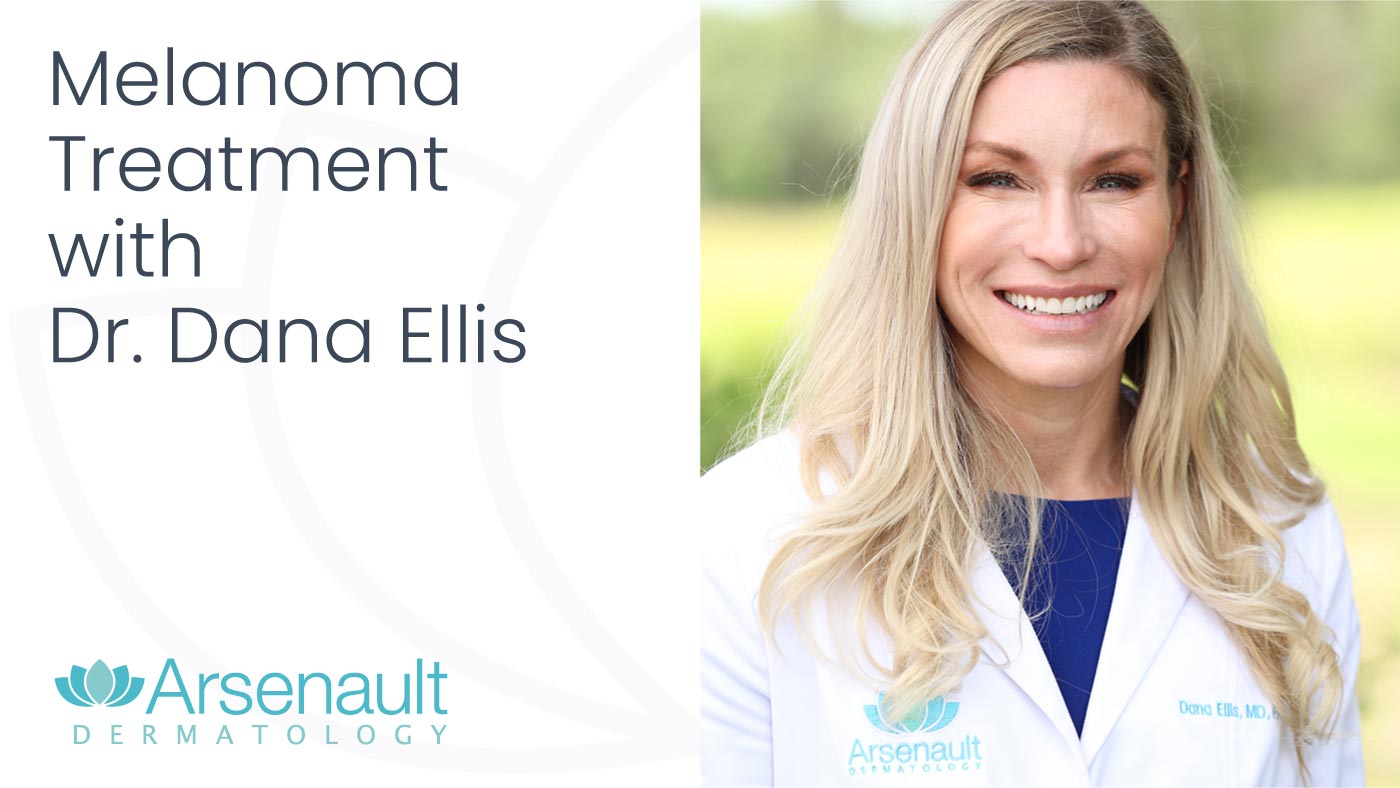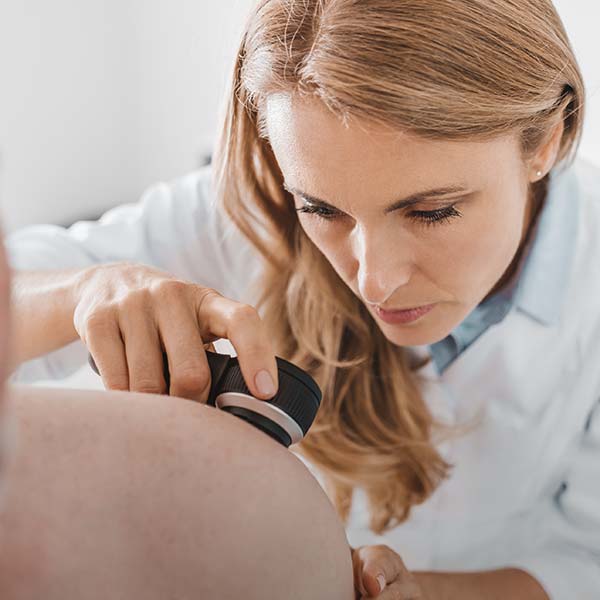Melanoma & Skin Cancer
We provide unparalleled expertise in the prevention, early detection and treatment of Melanoma. Experience the peace of mind that comes from our patient-centric approach to skin cancer. That’s the Arsenault Dermatology difference.
Melanoma and Your Health
Melanoma is a type of skin cancer that develops when melanocytes (the cells that give the skin its tan or brown color) start to grow out of control.
While less common than other types of skin cancers, melanoma is more dangerous because it is more likely to spread to other parts of the body if not caught and treated early.
The vast majority of melanoma cases are due to excess UV exposure, either from sunlight or indoor tanning beds. Genetics can also play a role.
People of all ages and skin types can get melanoma. However, your risk increases if you have:
- a large number of moles
- a personal or family history of melanoma and other non-melanoma skin cancers
- a fair complexion with red or blonde hair and blue or green eyes
- an immunocompromised condition
- a history of other internal cancers

Spotlight:
Melanoma Prevention
Limiting your UV exposure is the most important thing you can do to prevent melanoma. Floridians should:
- seek shade when outdoors, especially between the hours of 10 AM and 2 PM
- wear sun protective UPF clothing
- apply a broad-spectrum, mineral based, water resistant sunscreen with an SPF of 30 or higher and reapply frequently
- avoid tanning beds
- perform regular self skin exams
Prevention is key when it comes to your skin health!

By far, the best approach to Melanoma is to catch it early. Last year at Arsenault Dermatology the majority of diagnosed melanomas were caught in earliest stage.
Early Detection
The key to early detection of melanoma is to be on the lookout for atypical moles.
An atypical mole is visibly and pathologically different than normal moles. They are often variable in color and have irregular borders.
Although these moles are usually friendly, your dermatologist will still monitor them closely for signs of early transition into melanoma.

Self Exams
We partner with our patients to provide education and resources so they know what to look for at home.

Regular Skin Checks
All Arsenault Dermatology providers specialize in performing detailed full body skin exams to detect skin cancers as early as possible.

Mole Mapping
We take the time to perform sequential mole mapping over years. This helps us immediately identify the slightest changes concerning for melanoma.
Spotlight:
Mole Mapping
When it comes to moles, there are normal moles, malignant moles, and moles in-between. We consider those to be pre-cancerous. The key to preventing melanoma is detecting early changes in pre-cancerous moles.
We believe strongly in mole mapping to detect these changes early. By taking the time to meticulously document the size and shape of atypical moles over time, we create a personalized map we use to make the most accurate clinical decisions about your care.
With sequential mole mapping, we record extremely accurate measurements (within 0.5mm). That’s extremely small! Mole mapping provides us with a baseline from which to identify when and how a mole has changed, so that we can take decisive action as early as possible.

Spotlight:
Dermoscopy
Dermoscopy saves lives.
We use dermoscopy to closely evaluate your skin. The magnification and lighting provided by this hand-held device allows your dermatologist to differentiate which lesions need to be biopsied. All of our providers at Arsenault Dermatology use this technique to identify skin cancers in their earliest state.
Dermoscopy requires advanced training to use properly. Arsenault Dermatology believes so strongly in this technique, that all of our providers are trained how to use this life-saving technology.

Melanoma Treatment
What does melanoma look like?
Melanomas often follow the "ABCDE" rule:
- A is for asymmetry.
- B is for border. Often the borders of melanomas are scalloped and irregular.
- C is for color. Melanomas will often vary in color throughout the same lesion.
- D is for diameter. Melanomas are often greater than 6 mm in size . . . larger than a pencil eraser.
- E is for evolving.
We educate all our patients to look for changes in size, shape and color of their pre-existing moles.
How does my doctor diagnose melanoma?
With melanomas, early detection is essential. Your dermatologist will perform a full-body skin examination at least once a year or more depending on your underlying risk factors. If your dermatologist suspects melanoma, a small biopsy is performed to help confirm the diagnosis.
What symptoms can I expect?
In the early stages, melanoma's symptoms are usually limited to visual changes only. During later stages, or once the melanoma has metastasized or spread, patients may experience bleeding, local pain in the skin, tender lymph nodes, fatigue and possibly weight loss.
Can melanoma be cured?
The majority of melanomas, if caught early, can be cured by surgery alone. Later stages are first treated surgically, and then patients can have good outcomes with the addition of radiation, chemotherapy or newer immunotherapies.
Does melanoma spread to other parts of the body?
Unfortunately in later stages, melanomas can spread throughout the body including the bones, brain, liver, lungs, lymph nodes and stomach. This is why we put so much energy into early detection.
Schedule your Arsenault Dermatology full-body screening today.
Melanoma FAQs
Melanoma is the most serious form of skin cancer. The number of people who get this cancer is increasing. Being informed is the first step to staying healthy.
What does melanoma look like when it first starts?
The first sign of melanoma is often a mole that changes size, shape or color. Moles that develop color variations or irregular borders are suspicious for melanoma.
How does my provider make the diagnosis?
We detect melanomas through regular full-body skin exams, using dermoscopy for a closer look. Suspicious lesions are biopsied and the diagnosis is made by microscope.
Can melanoma spread to other organs?
Yes, in later stages melanoma can spread anywhere in the body including the lungs, liver, brain, bones, GI system and lymph nodes. This is why we focus on early detection to saves lives.
If I get melanoma, what are my chances of survival?
Detected in its earliest and most treatable stage, the average five-year survival rate for patients is 99%. This number decreases substantially with the regional and distant spread of the cancer.
Does melanoma run in families?
Around 10% of people with melanoma have a family history of the disease. This can be because of shared genetics or shared lifestyle habits of frequent sun exposure without adequate protection.
Can melanoma be benign?
While melanomas do grow out of moles, and while most moles are benign, melanoma (by definition) is a cancer. Our skilled providers are highly trained and can tell the difference between "friendly" moles, and those concerning for melanoma.
Can melanoma be cured?
Early detection and treatment can completely cure melanomas. However, underlying risk factors such as family history and earlier life sun exposure pose an ongoing risk for the development of future melanomas.
What can Arsenault Dermatology do for me?
The detection and treatment of melanoma is our highest clinical priority. Once a patient receives the diagnosis, they enter into our Melanoma Program designed to prioritize frequent skin checks and early detection.
Skin Cancer Testimonial
What Our Patients Are Saying
These people are skilled throughout the entire process from booking to surgery and each person I had contact with was so incredibly nice and caring. You have a wonderful staff and my appreciation for a job well done. Thank you for your kindness and caring, you all deserve 5 stars!
Arsenault is an excellent practice, & I highly recommend them.
Trust Arsenault Dermatology
If you would like to be seen by the melanoma experts at Arsenault Dermatology for your skin cancer needs, please contact us to experience the Arsenault advantage.




